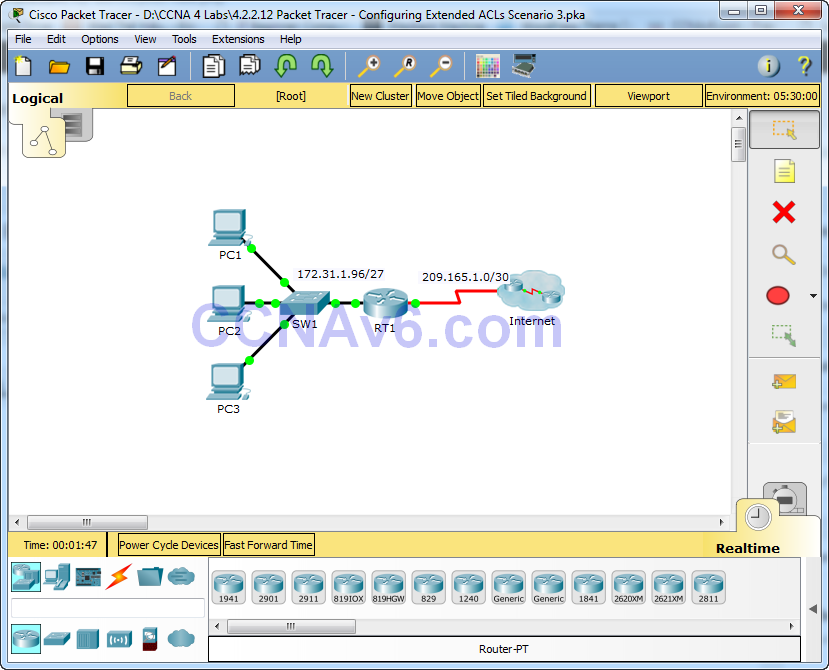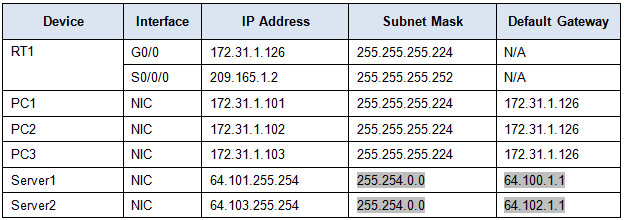Packet Tracer – Configuring Extended ACLs – Scenario 3
(Instructor Version)
Instructor Note: Red font color or Gray highlights indicate text that appears in the instructor copy only.
Topology

Addressing Table

Objectives
Part 1: Configure a Named Extended ACL
Part 2: Apply and Verify the Extended ACL
Background / Scenario
In this scenario, specific devices on the LAN are allowed to various services on servers located on the Internet.
Part 1: Configure a Named Extended ACL
Use one named ACL to implement the following policy:
· Block HTTP and HTTPS access from PC1 to Server1 and Server2. The servers are inside the cloud and you only know their IP addresses.
· Block FTP access from PC2 to Server1 and Server2.
· Block ICMP access from PC3 to Server1 and Server2.
Note: For scoring purposes, you must configure the statements in the order specified in the following steps.
Step 1: Deny PC1 to access HTTP and HTTPS services on Server1 and Server2.
a. Create an extended IP access list named ACL which will deny PC1 access to the HTTP and HTTPS services of Server1 and Server2. Because it is impossible to directly observe the subnet of servers on the Internet, four rules are required.
What is the command to begin the named ACL?
ip access-list extended ACL
b. Record the statement that denies access from PC1 to Server1, only for HTTP (port 80).
deny tcp host 172.31.1.101 host 64.101.255.254 eq 80
c. Record the statement that denies access from PC1 to Server1, only for HTTPS (port 443).
deny tcp host 172.31.1.101 host 64.101.255.254 eq 443
d. Record the statement that denies access from PC1 to Server2, only for HTTP.
deny tcp host 172.31.1.101 host 64.103.255.254 eq 80
e. Record the statement that denies access from PC1 to Server2, only for HTTPS.
deny tcp host 172.31.1.101 host 64.103.255.254 eq 443
Step 2: Deny PC2 to access FTP services on Server1 and Server2.
a. Record the statement that denies access from PC2 to Server1, only for FTP (port 21 only).
deny tcp host 172.31.1.102 host 64.101.255.254 eq 21
b. Record the statement that denies access from PC2 to Server2, only for FTP (port 21 only).
deny tcp host 172.31.1.102 host 64.103.255.254 eq 21
Step 3: Deny PC3 to ping Server1 and Server2.
a. Record the statement that denies ICMP access from PC3 to Server1.
deny icmp host 172.31.1.103 host 64.101.255.254
b. Record the statement that denies ICMP access from PC3 to Server2.
deny icmp host 172.31.1.103 host 64.103.255.254
Step 4: Permit all other IP traffic.
By default, an access list denies all traffic that does not match any rule in the list. What command permits all other traffic?
permit ip any any
Part 2: Apply and Verify the Extended ACL
The traffic to be filtered is coming from the 172.31.1.96/27 network and is destined for remote networks. Appropriate ACL placement also depends on the relationship of the traffic with respect to RT1.
Step 1: Apply the ACL to the correct interface and in the correct direction.
a. What are the commands you need to apply the ACL to the correct interface and in the correct direction?
Step 2: Test access for each PC.
a. Access the websites of Server1 and Server2 using the Web Browser of PC1 and using both HTTP and HTTPS protocols.
interface g0/0 ip access-group ACL in
b. Access FTP of Server1 and Server2 using PC1. The username and password is “cisco”.
c. Ping Server1 and Server2 from PC1.
d. Repeat Step 2a to Step 2c with PC2 and PC3 to verify proper access list operation.

So where are the answers
I will add the answer soon.
you sure about that